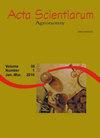桃和油桃对褐腐病的易感性及产孢评价方案优化
IF 1.2
4区 农林科学
Q3 AGRONOMY
引用次数: 2
摘要
引起果实褐腐病的霉菌是桃的主要病原菌之一。抗杀菌剂真菌分离株的出现,以及减少喷雾的尝试,有利于采用其他控制策略。其中,最重要的是遗传抗性。本研究旨在评价16个桃子和4个油桃基因型对褐腐病的易感性,以及孢子面积和直径与病损孢子数量的相关性。用10 μL的果霉悬浮液接种伤果和未伤果。所有基因型的伤果(油桃和桃子)对桃乳杆菌均表现出易感,发病率为92% ~ 100%。接种未伤果时,病害发生率为18% ~ 100%。在损伤和未损伤的果实中,真菌孢子量的变异率分别为16% ~ 96%和0% ~ 94%。不同基因型真菌的产孢量存在差异(在0.1 ~ 96.0个/ mm2之间),且与产孢直径和产孢面积呈正相关。基因型Conserva 947、Conserva 1662、Conserva 672、Conserva 1600和‘Bolinha’对褐腐病不太敏感。本文章由计算机程序翻译,如有差异,请以英文原文为准。
Peach and nectarine susceptibility to brown rot and protocol optimization to evaluate Monilinia fructicola sporulation
The fungus Monilinia fructicola, which causes brown rot in fruits, is one of the main peach pathogens. The emergence of fungicide-resistant fungus isolates, as well as the attempt to reduce sprays, favors adoption of other control strategies. Among them, one of the most important is genetic resistance. This study was carried out aiming to evaluate the susceptibility of 16 peach and 4 nectarine genotypes to brown rot, as well as to evaluate how well the sporulation area and diameter correlate with number of spores in the lesions. Both wounded and non-wounded fruits were inoculated with 10 μL of M. fructicola suspension. Wounded fruits from all genotypes (nectarines and peaches) showed susceptibility to M. fructicola, from 92 to 100% of incidence. The disease incidence was between 18 and 100% when non-wounded fruits were inoculated. High variability was detected for the fungus sporulation, in both wounded and non-wounded fruits, with ranges between 16 to 96% and 0 to 94%, respectively. The fungus sporulation was variable among the genotypes (between 0.1 to 96.0 conidia per mm2) and it is positively correlated with the diameter and area of sporulation. The genotypes Conserva 947, Conserva 1662, Conserva 672, Conserva 1600, and 'Bolinha', are the ones with less susceptible to brown rot.
求助全文
通过发布文献求助,成功后即可免费获取论文全文。
去求助
来源期刊

Acta Scientiarum. Agronomy.
Agricultural and Biological Sciences-Agronomy and Crop Science
CiteScore
2.40
自引率
0.00%
发文量
45
审稿时长
>12 weeks
期刊介绍:
The journal publishes original articles in all areas of Agronomy, including soil sciences, agricultural entomology, soil fertility and manuring, soil physics, physiology of cultivated plants, phytopathology, phyto-health, phytotechny, genesis, morphology and soil classification, management and conservation of soil, integrated management of plant pests, vegetal improvement, agricultural microbiology, agricultural parasitology, production and processing of seeds.
 求助内容:
求助内容: 应助结果提醒方式:
应助结果提醒方式:


